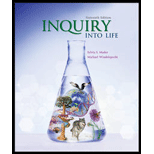
Inquiry into Life
16th Edition
ISBN: 9781260482638
Author: Mader, Sylvia
Publisher: MCGRAW-HILL HIGHER EDUCATION
expand_more
expand_more
format_list_bulleted
Textbook Question
Chapter 16.3, Problem 1CYP
Describe the three processes that are required for the excretion of a hypertonic urine.
Expert Solution & Answer
Want to see the full answer?
Check out a sample textbook solution
Students have asked these similar questions
The following table is from Kumar et. al. Highly Selective Dopamine D3 Receptor (DR) Antagonists and Partial Agonists Based on Eticlopride and the D3R Crystal Structure: New Leads for Opioid Dependence Treatment. J. Med Chem 2016.
The following figure is from Caterina et al. The capsaicin receptor: a heat activated ion channel in the
pain pathway. Nature, 1997. Black boxes indicate capsaicin, white circles indicate resinferatoxin.
You are a chef in a fancy new science-themed restaurant. You have a recipe that calls for 1 teaspoon of resinferatoxin, but you feel uncomfortable serving foods with "toxins" in them. How much capsaicin could you substitute instead?
What protein is necessary for packaging acetylcholine into synaptic vesicles?
Chapter 16 Solutions
Inquiry into Life
Ch. 16.1 - Prob. 1LOCh. 16.1 - Prob. 2LOCh. 16.1 - Prob. 3LOCh. 16.1 - Summarize the roles of the urinary system in the...Ch. 16.1 - Prob. 2CYPCh. 16.1 - Explain why urinary system diseases may cause...Ch. 16.2 - Identify the structures of a human kidney.Ch. 16.2 - Identify the parts of a nephron and state the...Ch. 16.2 - Distinguish between glomerular filtration, tubular...Ch. 16.2 - Identify the parts of a nephron that are found in...
Ch. 16.2 - Prob. 2CYPCh. 16.2 - Summarize how the kidney uses the processes of...Ch. 16.2 - Explain where in the nephron, and by what process,...Ch. 16.3 - Prob. 1LOCh. 16.3 - Prob. 2LOCh. 16.3 - Prob. 3LOCh. 16.3 - Describe the three processes that are required for...Ch. 16.3 - Prob. 2CYPCh. 16.3 - Prob. 3CYPCh. 16.3 - Prob. 4CYPCh. 16.4 - Summarize how damage to the glomeruli/nephrons can...Ch. 16.4 - Prob. 2LOCh. 16.4 - Prob. 3LOCh. 16.4 - Prob. 1QTCCh. 16.4 - Prob. 2QTCCh. 16.4 - Prob. 3QTCCh. 16.4 - Prob. 1CYPCh. 16.4 - Prob. 2CYPCh. 16.4 - Prob. 3CYPCh. 16 - Prob. S2.3BYBCh. 16 - Prob. F4.3BYBCh. 16 - Prob. S11.5BYBCh. 16 - Prob. 1ACh. 16 - Prob. 2ACh. 16 - Prob. 3ACh. 16 - Prob. 4ACh. 16 - Prob. 5ACh. 16 - Prob. 6ACh. 16 - Prob. 7ACh. 16 - Prob. 8ACh. 16 - Prob. 9ACh. 16 - Prob. 10ACh. 16 - Prob. 11ACh. 16 - Prob. 12ACh. 16 - Prob. 1TCCh. 16 - Prob. 2TCCh. 16 - Prob. 3TC
Knowledge Booster
Learn more about
Need a deep-dive on the concept behind this application? Look no further. Learn more about this topic, biology and related others by exploring similar questions and additional content below.Similar questions
- 1. Match each vocabulary term to its best descriptor A. affinity B. efficacy C. inert D. mimic E. how drugs move through body F. how drugs bind Kd Bmax Agonist Antagonist Pharmacokinetics Pharmacodynamicsarrow_forward50 mg dose of a drug is given orally to a patient. The bioavailability of the drug is 0.2. What is the volume of distribution of the drug if the plasma concentration is 1 mg/L? Be sure to provide units.arrow_forwardDetermine Kd and Bmax from the following Scatchard plot. Make sure to include units.arrow_forward
- Choose a catecholamine neurotransmitter and describe/draw the components of the synapse important for its signaling including synthesis, packaging into vesicles, receptors, transporters/degradative enzymes. Describe 2 drugs that can act on this system.arrow_forwardThe following figure is from Caterina et al. The capsaicin receptor: a heat activated ion channel in the pain pathway. Nature, 1997. Black boxes indicate capsaicin, white circles indicate resinferatoxin. a) Which has a higher potency? b) Which is has a higher efficacy? c) What is the approximate Kd of capsaicin in uM? (you can round to the nearest power of 10)arrow_forwardWhat is the rate-limiting-step for serotonin synthesis?arrow_forward
arrow_back_ios
SEE MORE QUESTIONS
arrow_forward_ios
Recommended textbooks for you
 Human Physiology: From Cells to Systems (MindTap ...BiologyISBN:9781285866932Author:Lauralee SherwoodPublisher:Cengage Learning
Human Physiology: From Cells to Systems (MindTap ...BiologyISBN:9781285866932Author:Lauralee SherwoodPublisher:Cengage Learning Human Biology (MindTap Course List)BiologyISBN:9781305112100Author:Cecie Starr, Beverly McMillanPublisher:Cengage Learning
Human Biology (MindTap Course List)BiologyISBN:9781305112100Author:Cecie Starr, Beverly McMillanPublisher:Cengage Learning Biology (MindTap Course List)BiologyISBN:9781337392938Author:Eldra Solomon, Charles Martin, Diana W. Martin, Linda R. BergPublisher:Cengage Learning
Biology (MindTap Course List)BiologyISBN:9781337392938Author:Eldra Solomon, Charles Martin, Diana W. Martin, Linda R. BergPublisher:Cengage Learning Comprehensive Medical Assisting: Administrative a...NursingISBN:9781305964792Author:Wilburta Q. Lindh, Carol D. Tamparo, Barbara M. Dahl, Julie Morris, Cindy CorreaPublisher:Cengage Learning
Comprehensive Medical Assisting: Administrative a...NursingISBN:9781305964792Author:Wilburta Q. Lindh, Carol D. Tamparo, Barbara M. Dahl, Julie Morris, Cindy CorreaPublisher:Cengage Learning


Human Physiology: From Cells to Systems (MindTap ...
Biology
ISBN:9781285866932
Author:Lauralee Sherwood
Publisher:Cengage Learning

Human Biology (MindTap Course List)
Biology
ISBN:9781305112100
Author:Cecie Starr, Beverly McMillan
Publisher:Cengage Learning

Biology (MindTap Course List)
Biology
ISBN:9781337392938
Author:Eldra Solomon, Charles Martin, Diana W. Martin, Linda R. Berg
Publisher:Cengage Learning


Comprehensive Medical Assisting: Administrative a...
Nursing
ISBN:9781305964792
Author:Wilburta Q. Lindh, Carol D. Tamparo, Barbara M. Dahl, Julie Morris, Cindy Correa
Publisher:Cengage Learning
Excretory System; Author: Amoeba Sisters;https://www.youtube.com/watch?v=q5qaGHfdmYM;License: Standard youtube license